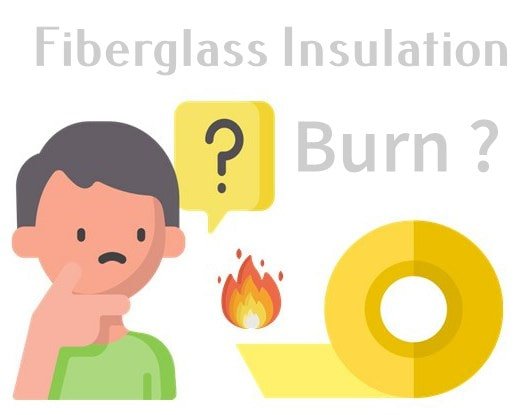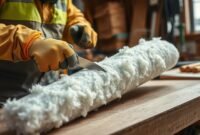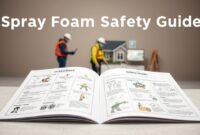Are you worried about the fire risks of fiberglass insulation in your home? Many homeowners share this concern. The fear of fire hazards is high, given insulation’s close proximity to electrical systems and structural elements.
Fiberglass insulation is a popular choice for home protection. But, it’s important to understand its fire-resistant properties. I’ll explain if fiberglass insulation will burn and its safety features.
By exploring the science behind fiberglass insulation, you’ll feel more confident in its performance during extreme heat. Get ready to learn the truth about this essential building material’s fire safety.

Understanding Fiberglass Insulation Components
Fiberglass insulation is a remarkable engineering achievement. It turns simple materials into a strong thermal barrier for homes and buildings. Let’s explore the key parts that make it so effective and unique.
Read also: Can You Burn Insulation?
Primary Materials in Fiberglass
Fiberglass insulation is made from several important ingredients. These include:
- Recycled glass cullet
- Pure silica sand
- Specialized mineral additives
- Fire-resistant chemical compounds
Manufacturing Process Overview
The making of fiberglass insulation is a precise process. I’ll explain the main steps that ensure its high-quality fire resistant properties.
- Raw materials are melted at very high temperatures.
- Fibers are formed through special spinning techniques.
- They are treated with fire-resistant agents.
- Then, they are cut and packaged for use.
Role of Binding Agents
Binding agents are key in fiberglass insulation. They give the material structure and boost its thermal performance. These compounds help keep the material cohesive and effective.
| Binding Agent Type | Primary Function | Fire Resistance Impact |
|---|---|---|
| Phenol-formaldehyde resins | Structural cohesion | High heat resistance |
| Acrylic polymers | Flexibility enhancement | Moderate flame retardant properties |
| Silane coupling agents | Fiber bonding | Improved thermal stability |
Knowing about these components shows why fiberglass insulation is a trusted thermal barrier for modern buildings.
Fire-Resistant Properties of Modern Fiberglass
Fiberglass insulation is a standout material with top-notch fire resistant properties. Its unique mix makes it hard to burn, adding safety for homes. Glass-based materials naturally stop fires from spreading, making fiberglass a great choice for homes and businesses.
The fire resistance of fiberglass comes from its non-organic parts. Unlike organic materials that burn easily, fiberglass has mineral-based parts that lower its chance to catch fire. When it gets very hot, fiberglass insulation resists starting a fire and slows it down.
- Composed of glass fibers and mineral materials
- Naturally non-combustible construction
- Melts instead of burning under extreme heat
- Provides critical fire barrier protection
Manufacturers also add special treatments to improve fiberglass’s fire resistance. These treatments help it handle high temperatures better and reduce fire risks. This makes fiberglass insulation a safe and efficient choice.
| Fire Resistance Characteristic | Performance Rating |
|---|---|
| Ignition Temperature | 1000°F+ (538°C) |
| Flame Spread Index | 25 or lower |
| Smoke Development | Low |
Knowing about fiberglass’s fire-resistant features helps homeowners choose the right insulation. Fiberglass gives peace of mind by protecting against fires and keeping homes warm.
Will Fiberglass Insulation Burn in Different Conditions
Knowing how fiberglass insulation reacts to heat is key for homeowners and builders. It’s vital to understand its fire-resistant qualities and how it performs under different conditions.
Fiberglass insulation stands out for its fire-resistant properties. I’ll explain how it behaves with various heat sources and temperatures.
Temperature Thresholds for Melting
Many wonder if fiberglass insulation will burn. The answer is no. It keeps its shape up to very high temperatures. Here are the important temperature points:
- Maintains structure: Up to 1,000°F (538°C)
- Glass fiber melting point: 2,200°F (1,204°C)
- Does not support combustion: Inherently fire-resistant
Reaction to Direct Flame Exposure
Experts warn against burning insulation. Fiberglass reacts differently to direct flames:
| Heat Exposure Level | Fiberglass Reaction |
|---|---|
| Low Heat | Remains stable, no combustion |
| Moderate Heat | Begins to deform, does not ignite |
| High Heat | Melts but does not produce flames |
Impact of Heat Sources
Heat sources affect fiberglass insulation in unique ways. While burning insulation is rare, knowing its behavior is important for safety. Home heat sources like wiring, fireplaces, or heaters are unlikely to harm fiberglass insulation.
Always get professional installers for the best fire safety. They ensure fiberglass insulation is installed correctly in your home or project.
Read also: How Long Does Fiberglass Insulation Last
Safety Standards and Fire Ratings

Choosing the right insulation for homes and buildings is key. Fiberglass insulation is tested to meet top safety standards. It goes through a detailed process to check its fire resistance.
Independent labs test fiberglass under harsh conditions. They check its performance in several areas. This makes it a safe choice for homes and buildings.
- Flame spread rating
- Smoke development characteristics
- Combustibility thresholds
- Thermal resistance capabilities
Insulation must meet fire codes to be safe. Fiberglass always meets these high standards. That’s why experts often suggest it for homes and buildings.
Fiberglass usually gets a Class A to Class C fire rating. This shows it’s very good at stopping fires from spreading. This rating helps people choose the safest insulation.
Companies must follow national building codes and standards. Groups like ASTM International and the International Code Council set these rules. They make sure fiberglass insulation protects well against fires.
Heat Response and Melting Behavior
I’ve studied how fiberglass insulation handles extreme temperatures. It’s important for safety in homes and buildings.
Fiberglass insulation has special heat properties. It changes in unique ways when it gets hot:
Thermal Degradation Process
Burning fiberglass insulation changes slowly. The glass fibers can handle high heat, but the glue and backing can’t. Here’s what happens:
- Glass fibers stay strong up to 1,000°F
- Glue starts to break down at 300-400°F
- It doesn’t collapse much when heated
Smoke Production Levels
Fiberglass insulation doesn’t make much smoke when it burns. It’s different from many other materials. The glass fibers don’t release harmful fumes.
Chemical Changes Under Heat
Fiberglass insulation changes a bit when it gets very hot. The glue might release some gases, but the glass stays the same. This makes fiberglass safer than some other materials.
Knowing how fiberglass insulation acts in heat helps us make better choices. It’s good for safety and performance in hot conditions.
Professional Installation Requirements for Fire Safety
Professional installation of fiberglass insulation is not just a luxury. It’s a must for fire safety. Fire codes require specific techniques to protect your home. I’ve seen many DIY projects fail, risking both safety and energy savings.
Experts in installation know more than just filling spaces. They follow strict fire safety rules, making sure your insulation meets high standards. Here are the main points of professional installation:
- Maintaining proper clearances around heat sources
- Ensuring complete and uniform coverage
- Preventing compression that reduces insulation effectiveness
- Verifying compliance with local fire codes
Your home’s safety relies on the right installation methods. Professionals use special tools and skills to create a fire barrier. They know how to work with fiberglass to enhance its fire-resistant qualities.
| Installation Consideration | Professional Approach |
|---|---|
| Heat Source Proximity | Minimum 3-inch clearance maintained |
| Material Compression | Avoided to preserve thermal performance |
| Fire Code Compliance | Verified and documented |
Choosing professional installation might seem costly. But it’s a wise investment for your home’s safety. You’re not just getting insulation. You’re getting peace of mind and full fire safety protection.
Comparing Fiberglass to Other Insulation Materials
Choosing the right insulation for your home is key. Fiberglass is a top pick for many, thanks to its reliable warmth protection. Let’s look at how it stacks up against other options.
Fire Resistance Ratings Comparison
Fiberglass shines in fire safety. It doesn’t need fire retardants to stay safe, unlike some other materials. This makes it a better choice than cellulose or organic insulations.
| Insulation Type | Fire Rating | Additional Treatment Needed |
|---|---|---|
| Fiberglass | Class A (Highest) | No |
| Cellulose | Class B | Yes |
| Spray Foam | Class C | Yes |
| Mineral Wool | Class A | No |
Cost-Benefit Analysis
Fiberglass is a smart choice for your wallet and your home. Here’s why:
- It’s cheaper to install upfront
- It needs little upkeep
- It lasts a long time
- It keeps your home warm efficiently
Environmental Impact Factors
Fiberglass is also good for the planet. It’s made from recycled materials and helps save energy by keeping your home warm.
Maintaining Fire-Resistant Properties Over Time

It’s important to keep your fiberglass insulation in good shape. This helps it stay fire resistant. Regular checks are key to keeping your home safe and well-insulated.
I suggest checking your fiberglass insulation once a year. Look for signs of damage or wear:
- Moisture accumulation
- Visible compression or sagging
- Signs of pest infestation
- Discoloration or unusual odors
Environmental factors can affect your insulation. Places with high humidity or extreme temperatures need more checks. Pay extra attention to attics, basements, and crawl spaces.
| Inspection Area | Recommended Frequency | Key Concerns |
|---|---|---|
| Attic | Annually | Moisture, ventilation, compression |
| Basement | Bi-Annually | Water damage, pest intrusion |
| Exterior Walls | Every 2-3 Years | Settling, thermal performance |
If you find any problems with your insulation, fix them right away. Bad insulation can make your home less safe. For big issues, get a pro’s help.
Being proactive with your insulation keeps it working well. This protects your home for many years.
Common Misconceptions About Fiberglass and Fire
Many homeowners have wrong ideas about fiberglass insulation and fire safety. I’ve heard many myths that can cause worry or false confidence. These myths can affect how we protect our homes.
Let’s debunk some common myths about fiberglass insulation burn risks and paper foil backings. Not all insulation is the same. Knowing the differences can help you choose safer options for your home.
- Myth: All insulation burns the same way
- Reality: Fiberglass has unique fire-resistant properties that set it apart from other materials
- Misconception: Paper foil backing makes insulation highly flammable
- Fact: Modern fiberglass insulation is designed with fire safety in mind
Some people think fiberglass insulation catches fire easily or spreads flames fast. But, fiberglass is made to resist burning. It acts as a strong barrier against fire spread. The paper foil backing in some insulation is treated to be fire-safe.
Fiberglass is different from other insulation materials. For example, cellulose insulation is more likely to catch fire. Fiberglass is made to keep its shape and protect even when it’s very hot.
Knowing these differences helps you make better choices for your home’s insulation and fire safety. Always talk to professional installers for advice on the best insulation for your needs.
Conclusion
Exploring fiberglass insulation, I found it to be a top pick for homes and buildings. It’s not just about safety; it’s also cost-effective. Homeowners looking for both safety and performance will find it excellent.
We’ve looked into how fiberglass insulation handles extreme temperatures. Its special mix helps protect against fires, giving homeowners confidence. To get the most out of it, proper installation and care are essential.
Choosing insulation for your home requires knowing the details. Fiberglass insulation is great for keeping temperatures right and preventing fires. It’s a leading choice for homes and businesses in the U.S. because of its heat resistance and fire safety.
When picking insulation, knowing the facts is key. Fiberglass insulation’s fire safety is a big plus. This knowledge helps you choose wisely, keeping your property safe and comfortable for years.


